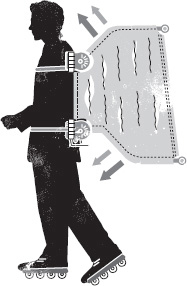Uncle John’s Bathroom Reader Weird Inventions (18 page)
Read Uncle John’s Bathroom Reader Weird Inventions Online
Authors: Bathroom Readers’ Institute

S
ome of the world’s biggest and best cities also have some of the world’s biggest and best parks, perfect for jogging or bicycling. The problem is that those big cities are often horribly smog-choked, particularly on warm, sunny days; times that are preferred for outdoor exercise are rendered toxic by air pollution. The solution: the Greenhouse Helmet. More than just a plastic bubble protecting you and your lungs from the bad air outside, it’s a complete mini-ecosystem inside.

It consists of a large plastic dome that seals firmly around the head. Inside are tiny shelves outfitted with plants, which, you might remember from junior-high science class, take in the carbon dioxide humans expel, and in turn expel oxygen. This creates an environment of a constant exchange of clean air.
And so you don’t have to come across as a complete weirdo, the Greenhouse Helmet comes with speakers and a microphone for communicating with people who are not inside the Greenhouse Helmet.
T
here are few sensations that can compare to riding the range on a strong stallion, but if you’re one of the few couch cowboys who can’t be bothered to stop watching reruns of
Gunsmoke
and
Bonanza
long enough to hop into the saddle, fear not: In the early 1980s, an astute inventor came up with the perfect solution to your problem.
If the idea of a remote-controlled horse sounds laughable and self-defeating, that’s only because it is. After equipping your trusty steed with the appropriate saddle, you’ll be able to use your joystick to control the mechanized reins, thereby steering the horse in whichever direction you choose. For sadists, there’s also the added bonus of being able to use the remote control to activate a whip to keep your horse in line. (This product has not been endorsed by PETA.)
Given how few jockeys have been replaced by this system, it’s fair to say that this remote control has yet to revolutionize the world of horse racing, but with a few tweaks to New York City’s budget, just imagine how relaxed those guys driving the carriages around Central Park could be.
W
aste not, want not” is one of those phrases you don’t hear much anymore, but it’s the kind of thing our Depression-era grandmothers liked to say. Which is why we wish they were still around to enjoy the Stack Infinite Soap Bar Cycle, a brilliantly goofy innovation that takes those words to a whole new level.
The idea here is pretty simple: Ordinary bars of soap, no matter how nice they smell or how good they are at cleaning us off, always end up as useless slivers that prevent us from getting every penny of our money’s worth. To solve the problem, the folks at Stack devised a design with a “unique grooved shape” that you can use to “piggyback” your old soap onto a brand new bar, thus creating what they’re calling the world’s first “waste-free Infinite Cycle of Soap.”
Of course, as our grandmother probably would have been quick to point out (while sternly wagging her finger), there’s nothing stopping you from just squeezing your ordinary soap slivers into a plain old new bar that doesn’t cost $13. But where would this great nation be if we ignored inventions that cost us extra money in the name of saving us money?
A
ccording to the sketches that accompanied the 1998 patent filing, the Human Sail looks like a full-body apparatus that transforms the wearer into a superhero, enabling flight and super-speed both in the air and on land. After all, it includes a strap-on backpack, mechanical wings, and inline skates. The truth is far less interesting: It’s called a “body mounted sail assembly.” Rather than turn a person into a super-human, it turns them into a human sailboat. The “wings” on the back are sails; the user flaps the wings, ever so gently, to capture the wind and propel themselves forward…on their roller skates. It’s basic physics, nothing more, nothing less, and a great labor-saving device for someone who likes to roller skate but is too lazy to lean forward or propel themselves by their own power.

T
he Baby Cage
Pediatricians have long debated the physical and emotional ramifications of “co-sleeping”—parents allowing baby to sleep in bed with them, rather than in a crib of their own down the hall. One genius sought to solve the very real and very frightening logistical concerns of co-sleeping (baby rolling off the bed, parents rolling onto baby) by inventing the Baby Cage, an oval dome that keeps baby locked inside and in place. And it’s laced with curved crossbars sturdy enough to hold a parent’s weight in case of a roll-over. So, hooray, baby survives the night…locked in a tiny prison.

The Diaper Alarm
One of the less appetizing perks of bringing up baby is the diaper check: the pat, the sniff, the grope that helps a parent figure out when it’s time to make a change before the nappy runneth over. Putting a stop to such indignities was the goal of the Diaper Alarm, a battery-powered sensor that attached to the Huggies and initiated a mild electrical induction when wet, culminating in flashing lights and an audible alarm. A pool of pee-pee, a jolt of electricity, and baby’s little privates—what could go wrong?
The Baby Patter
How far will new parents go for a good night’s sleep? Apparently not far enough to make a fortune for the inventor of the Baby Patter, which provides a very loose interpretation of the word “soothe.” Designed with the notion that an occasional tender touch keeps a sleeping infant content, the Patter attached to a crib and featured a motorized, robotlike arm—with “hand” attached—that sporadically would spring to life (gently, let’s hope) and “pat” the sleeping baby’s bottom. Can you feel the (robot) love tonight? So can baby…as long as it doesn’t scooch around to face the opposite direction.
Cry No More
Millions of parents rely on the pacifier, that rubbery replacement for the comfort that only mom once could provide. Trouble is, babies eventually gain a pesky measure of autonomy, which too often results in the spit-out, the grab-and-fling, and other maneuvers that interrupt pacification and send parents diving under the sofa or reaching for the sanitizer. Cry No More was designed to end all that. It attached a binky semi-permanently to baby’s face via circular straps that lassoed around the ears. Never mind that it left baby looking like Hannibal Lector in mid-transport and one bad breath away from choking.
B
uried 100 feet below the Hudson River, the Lincoln Tunnel is one of the world’s busiest passageways, connecting New Jersey to Manhattan. On an average day, over 100,000 vehicles chug through its three tubes. And since 1961, officers working for the Port Authority of New York and New Jersey have had an invaluable weapon at their disposal to help fight crime and traffic jams tin the tunnel: Catwalk Cars.
When they debuted, the single-wheeled cars were fueled by gasoline as they sped along narrow catwalks attached to the edges of the tunnel’s tubes. The 550-pound vehicles, which looked sort of like bumper cars and were constructed of aluminum and plastic, could move forward or backward at up to 30 mph.
Nowadays, officers monitor traffic in the Lincoln Tunnel 24 hours a day and are perpetually on alert. Given their proximity to New York City, the tubes are considered high-risk terrorist targets, but a more common threat to commuters is traffic delays. To help keep up with the ever-increasing number of motorists down there, the catwalk cars have been updated. The modern ones are lighter, faster, powered by electricity, and parked in 4’ x 8’ booths strategically stationed near the spots where incidents most often occur. Each of the tunnel’s tubes has two of them. When things go wrong, an officer jumps into one of the tiny cars and races off like Batman to the rescue.
T
here are a lot of inventions out there claiming to cure baldness or regrow hair—helmets, lasers, creams, and surgeries, for example. But this invention is merely a technique for combing hair in a particular, yet very elaborate, way so that men who have lost all the hair on the tops of their heads (but not the sides) can make do with what they’ve got and trick any observers. (Also: You can indeed patent a technique or method of doing something with the U.S. patent office).

Registered in 1975, this “method of concealing partial baldness” takes the old trick of flapping a wave of hair from one side of the head over to the other to cover a bald spot and takes it to the next level. First, a man who is bald on top must grow out his hair in the back and on the sides, as long as it will go, until it hangs down like floppy drapes. Then, the method instructs, he carefully combs over each section, one at a time, layering them. The end result: short hair on the sides, full hair on top. (Keep it in place by spraying down each section with hair spray once it’s lying flat.)
NEW FRONTIERS IN CAFFEINE DISPERSAL
B
ecause drinking a cup or a can of something can take too long, you can now get these products, all of them infused with caffeine and other stimulants:
• Gummi Bears
• Maple syrup
• Breath mints
• Soap
• Gum
• Hot sauce
• Marshmallows
• Body wash
• Time-release caffeine capsules
• Dissolvable strips
• Beef jerky
• Popcorn
• Bloody Mary mix
• Breath spray
• Bottled water
